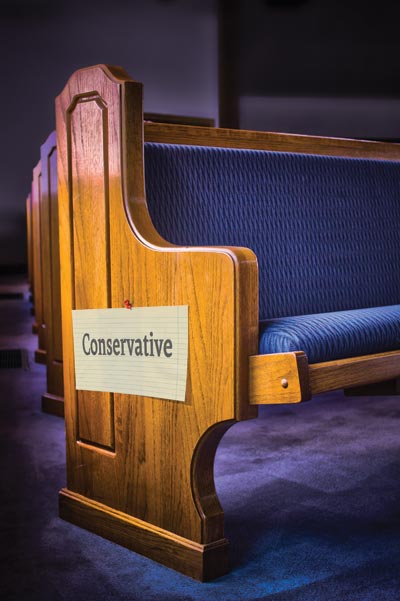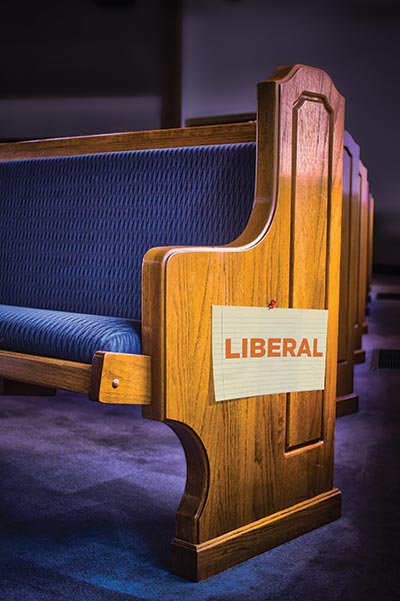
Some time ago a flyer arrived at my home announcing that Washington Water Power, a member company of the great hydroelectric power grid in the Northwest, was now Avista. The flyer promised “new management” and “better service.”
But it’s been worse.
My table saw seems to lack its earlier power; it takes longer for the toaster to pop up. Instead of 110 volts, we’re probably lucky to get 106. My imagination, you say? If it is, I’m sure it has to do with my sense that Avista is nothing but a low-voltage name if I ever heard one, better fit for a subcompact car or a New Age journal.
Clearly the Avista brand name is not one of my fascinations. Not at all like the name Seventh-day Adventist: You and I have been quite proud, in the most godly way, to wear that name, plain and simple. We have never had to qualify it with “Southern,” “Canadian,” “Orthodox,” “Primitive,” or other, as a way of officially defining subgroups with differing doctrinal positions. Never, it seems, until today—and that without even the benefit of a flyer in the mail! Have you noticed how common it now is, in the North American Division at least, for members to think and speak of each other as either “liberal” or “conservative” when we introduce Seventh-day Adventist names or identify Seventh-day Adventist congregations?
Unfortunately for the “moderates,” that third designation seems in practice not to be allowed because labels and identities seriously depend on positions held on the “hot potato” issues—celebration worship, women’s ordination, contemporary music, jewelry, homosexuality, wine sipping, etc.
“Liberal” and “conservative” have come to define a profound change in how Seventh-day Adventists perceive themselves, their message, and their mission. Identity is further complicated by contradictory ways of defining those labels. Liberals see themselves as loving, accepting, and forgiving; other members may see them as permissive, careless, or worldly. Conservatives see themselves as loyal, obedient, and principled; others see them as rigid, legalistic, or self-righteous. All sides may espouse a Christian unity that encompasses racial, economic, educational, and cultural differences. None may stand against statements such as the following: “God is leading out a people to stand in perfect unity upon the platform of eternal truth.”2 Yet I have come to wonder whether the day is upon us when both we and others will be left wondering what we and they mean by the name Seventh-day Adventist. I recommend we abandon the labeling game. And I have good reasons.
The articulation of our baptismal vows represents a theological breadth and depth unmatched anywhere else in the Christian world. Consistency with that common set of baptismal vows does not allow for rival sets of Seventh-day Adventists. To give the impression that it does amounts to deception. On the other hand, to accept the vows while making only partial commitment to them qualifies as hypocrisy. And to let such hypocrisy go unchallenged only exacerbates the deception—even if attendance increases here or there because we accommodate attitudes and behaviors, broad-minded or judgmental, that are inconsistent with our vows.
Perhaps the most profound deception in all this goes on in the mind of the now-accommodated member. Because “good and regular” standing with one’s church suggests that one also enjoys good standing before God.
This does not deny that every individual is moving along their own path toward “unity in the faith . . . to the whole measure of the fullness of Christ” (Eph. 4:13). Everyone needs time to become “rooted . . . and strengthened in the faith” (Col. 2:7). Everyone is ever pressing toward the mark of God’s high calling in Jesus (Phil. 3:14).
The consolidation of theologically contradictory groups creates division within the church. While admission depends on a unified standard, individuals sometimes feel free to continue to hold membership even after they have disallowed their original commitment to the church’s doctrines.
As groups develop and coalesce around the various modifications of practice, “liberal” or “conservative” labels serve as a helpful guide to those looking for a church home, to those deciding whether to stay or leave, and for administrators choosing pastoral leadership. The pastors themselves may also use that information in preparing sermons and planning their strategy for refereeing the expected or ongoing party strife.
One currently practiced solution has been to legitimatize the resulting division by creating two separate in-house congregations, each with its own worship service. Rather than worship in a house divided, however, some members have chosen to withdraw, scatter to other Adventist churches, or start their own labled congregation.
As a consequence, tension and alienation have increased among Adventist congregations, diminishing the free association and camaraderie that some church communities once enjoyed.
In Jesus’ parable of the sower (Matt. 13:3-23) the careless and worldly are clearly distinguishable from His committed and productive followers. In today’s church, however, there seems to be a place for including many diverse categories as followers of Jesus, simply tempered by the “liberal” label. Conservatives, of course, have always known, as Jesus’ contemporaries made clear, that they had unassailable right to the pews and offices of the church. Uncelebrated moderation in the middle seeks to establish common ground between voices speaking out boldly against long-established positions and other equally strong voices defending them in the name of truth.
Is our peacemaking moving us toward the abandonment of any idea of heresy? Calls for a firm stand have been known to inspire the cautionary reminder that “liberal” and “conservative” positions are both part of our current reality. What matters less is which is most Adventist. In any case, validated fuzziness about who we are makes it increasingly difficult for us to hold each other accountable.
Any increased polarity among us increases the odds that the public will be left confused.
At times our effort to improve our public image downplays the negative (against pork, coffee, jewelry, tobacco, etc.) and accentuates the positive (helpful good neighborliness). Thankfully we still go to church on Sabbath. But doesn’t shying away from our distinctive truths lead us toward that gray oblivion known as “modern Protestantism”?
Our “yea”s and “nay”s need to be merged. There is nothing unhealthy about being identified by what we say no to, as well as by the positive contributions we make to our communities. To do less or to be less threatens the mission of the church.
Some have taken to planting new churches without identifying them as Seventh-day Adventist even as, on the other hand, we take legal action against the unauthorized use of our name. No wonder both members and observers are confused and perplexed.
Meanwhile we note Ellen White’s insight that “the name, Seventh-day Adventist, is a standing rebuke to the Protestant world. . . . The name, Seventh-day Adventist, carries the true features of our faith in front, and will convict the inquiring mind.”3 She urges us “to stand firmly in defense of our principles
, in full view of the world.”4
Church members sometimes hesitate to invite non-Adventists to church-sponsored activities because they fear the witness of a divided church. Ellen White aptly describes our dilemma: “Those who stand outside will say, ‘It will be time enough for us to believe as you do when you can agree among yourselves as to what constitutes truth.’ ”5
Revelation characterizes Babylon as having become “a dwelling for demons and a haunt for every impure spirit, a haunt for every unclean bird” (Rev. 18:2); she is devoid of any redeeming qualities. Every truth has been corrupted, every doctrine turned into a lie. “A terrible condition of the religious world is here described.”6
America’s mainline Protestant churches tell a cautionary tale about liberalism. These churches have helped to shape America, serving as the spiritual guides of millions, including presidents, legislators, and business leaders. Now they are largely ignored. They have abandoned the moral authority of the Bible, and are left with little to offer.
An Episcopal historian observes that “Christianity in modern America is, in large part, innocuous. It tends to be easy, upbeat, convenient, and compatible. It does not require self-sacrifice, discipline, humility, an otherworldly outlook, a zeal for souls, a fear as well as love of God. There is little guilt and no punishment, and the payoff in heaven is virtually certain. The faith has been overwhelmed by the culture.”7
Seventh-day Adventists have been assigned the task of giving the second angel’s message to the adherents of these churches. But what can we say to them if our witness is divided between the extremes of a harsh legalism and an insipid liberalism? Shall we warn and win them with a compassionate preaching of the three angels’ messages, or shall we waste their time and ours with innovative ministries whose chief appeal is their entertainment value? Is it by our distractions that we hope to rescue the perishing from Babylon’s doom?
“The Word of God and His downtrodden law are to be made prominent in so marked a manner that men and women, members of other churches, shall be brought face to face, mind to mind, heart to heart with truth. They will see its superiority over the multitudinous errors that are . . . pushing their way into notice.”8
It may seem there is little the individual member can do to turn back the tide. “Conservative” and “liberal” are so embedded in our thinking and vocabulary that they will likely remain until the shaking purifies and unites our church. In the meantime, what we can do and ought to do is to continually assess our own lives for balance. As in all else, we do that best by studying the life of Jesus. Notice how He achieved perfect moral equilibrium in His life:
“The Savior’s entire life was characterized by disinterested benevolence and the beauty of holiness. He is our pattern of goodness. From the beginning of His ministry, men began to comprehend more clearly the character of God. He carried out His teachings in His own life. He showed consistency without obstinacy, benevolence without weakness, tenderness and sympathy without sentimentalism. He was highly social, yet He possessed a reserve that discouraged any familiarity. His temperance never led to bigotry or austerity. He was not conformed to the world, yet He was attentive to the wants of the least among men.”9 What a model for us to follow!
Isn’t it time to put away our misleading labels and accept anew the name the Lord Himself chose for us, letting it stand fully defined by every belief we espouse as a denomination? “Let us take our position as Seventh-day Adventists. [That] name is a true expression of our faith. I am instructed to call upon God’s people to bring their actions into harmony with their name, of which they have no need to be ashamed. The Seventh-day Adventist faith will bless whenever it is brought into the character-
building.”10
God helping me, that is the position I take, the name I choose to honor, the blessing I desire. I would be pleased if you would just call me a Seventh-day Adventist.